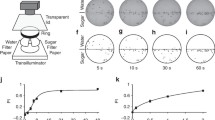Summary
The electrophysiological investigation of sugar receptors in different taste hairs ofProtophormia terraenovae (Diptera, Calliphoridae) has led to the following results:
-
1.
The reaction spectra of sugar receptors, based on the maximal receptor responses to a set of sixteen sugars, are equal in five different types of labellar taste hairs for sugars binding to the pyranose site. D-fructose which reacts on the furanose site, as well as the aryl glucosides 4-nitrophenyl-α-glucoside and phenyl-α-glucoside exert different stimulating effects in sugar receptors of different hair types.
-
2.
Mixtures of 4-nitrophenyl-α-glucoside with 1 mol/1 D-glucose and with 1 mol/1 D-fucose elicit 20 % enhanced responses in sugar receptors of the “large” labellar hairs, although D-glucose as well as D-fucose, if applied alone, induce maximal receptor responses.
-
3.
Sugar receptors of different tarsal taste hairs differ strikingly in their sensitivities to 4-nitrophenyl-α-glucoside which is a strong stimulus in “D”-type hairs, while it has almost no stimulating effectiveness in “B”-hairs.
It is suggested that 4-nitrophenyl-α-glucoside, one of the most effective stimuli for the sugar receptors of the fly, binds neither to the pyranose nor to the furanose site of the sugar receptor; probably it reacts on a new, hitherto unidentified receptor site. Evidences are discussed that the sugar sensitive labellar receptor cells of the fly may be a favourable object for the study of coding problems.
Similar content being viewed by others
References
Bradley RM (1971) Tongue topography. In: Beidler LM (ed) Handbook of sensory physiology, vol IV, Chemical senses, taste. Springer, Berlin Heidelberg New York, pp 1–30
Dethier VG (1976) The hungry fly. Harvard University Press, Cambridge, Massachusetts
Goldrich NR (1973) Behavioral responses ofPhormia regina (Meigen) to labellar stimulation with amino acids. J Gen Physiol 61:74–88
Grabowski CT, Dethier VG (1954) The structure of the tarsal chemoreceptors of the bowfly,Phormia regina Meigen. J Morphol 94:1–20
Hanamori T, Shiraishi A, Kijima H, Morita H (1972) Stimulation of labellar sugar receptor of the fleshfly by glycosides. Z Vergl Physiol 76:115–124
Hansen K (1968) Untersuchungen über den Mechanismus der Zucker-Perzeption bei Fliegen. Habilitationsschrift, Universität Heidelberg
Hansen K, Wieczorek H (1981) Biochemical aspects of sugar reception in insects. In: Cagan RH, Kare MK (eds) Biochemistry of taste and olfaction. Academic Press, New York London, pp 139–162
Hodgson ES, Roeder KD (1956) Electrophysiological studies of arthropod chemoreception. I. General properties of the labellar chemoreceptor of diptera. J Cell Comp Physiol 48:51–76
Jakinovich W Jr, Goldstein IJ, Baumgarten RJ, Agranoff BW (1971) Sugar receptor specificity of the fleshflySarcophaga bullata. Brain Res 35:369–378
Kikuchi T (1975) Genetic alteration of insect sugar reception. In: Denton DA, Coghland JP (eds) Proc Vth Int Symp Olfaction and Taste. Academic Press, New York, pp 27–31
Maes FW, Bijpost SCA (1979) Classical conditioning reveals discrimination of salt taste quality in the blowflyCalliphora vicina. J Comp Physiol 133:53–62
Maes FW, Vedder CG (1978) A morphological and electrophysiological inventory of labellar taste hairs of the blowflyCalliphora vicina. J Insect Physiol 24:667–672
Molen JN van der, Meulen JW van der, Kramer JJ de, Pasveer FJ (1978) Computerized classification of taste cell responses. J Comp Physiol 128:1–11
Morita H (1969) Electrical signs of taste receptor activity. In: Pfaffmann C (ed) Proc IIIrd Int Symp Olfaction and Taste. Rockefeller University Press, New York, pp 370–381
Morita H, Shiraishi A (1968) Stimulation of the labellar sugar receptor of the fleshfly by mono- and disaccharides. J Gen Physiol 52:559–583
Ninomiya M, Shimada I (1976) Stereospecificity for oligosac- charides of two receptor sites in a labellar sugar receptor of the fleshfly. J Insect Physiol 22:483–487
Pflumm W (1972) Molecular structure and stimulating effectiveness of oligosaccharides and glycosides. In: Schneider D (ed) Proc IVth Int Symp Olfaction and Taste. Wiss Verlagsges, Stuttgart, pp 364–370
Shimada I (1978) The stimulating effect of fatty acids and amino acid derivatives on the labellar sugar receptor of the fleshfly. J Gen Physiol 71:19–36
Shimada I, Isono K (1978) The specific receptor site for aliphatic carboxylate anion in the labellar sugar receptor of the fleshfly. J Insect Physiol 24:807–811
Shimada I, Shiraishi A, Kijima H, Morita H (1974) Separation of two receptor sites in a single labellar sugar receptor of the flesh-fly by treatment with p-chloromercuribenzoate. J Insect Physiol 20:605–621
Shiraishi A, Tanabe Y (1974) The proboscis extention response and tarsal and labellar chemosensory hairs in the blowfly. J Comp Physiol 92:161–179
Wieczorek H (1976) The glycoside receptor of the larvae ofMamestra brassicae L. (Lepidoptera, Noctuidae). J Comp Physiol 106:153–176
Wieczorek H (1980) Sugar reception by an insect water receptor. J Comp Physiol 138:167–172
Wieczorek H (1981) Sugar receptors in the labellar taste hairs of the fly. In: Salanki J (ed) Advances in physiological sciences, vol 23, Neurobiology of invertebrates. Pergamon Press/ Akadémiai Kiadó, Budapest, pp 481–493
Wieczorek H, Köppl R (1978) Effect of sugars on the labellar water receptor of the fly. J Comp Physiol 126:131–136
Wilczek M (1967) The distribution and neuroanatomy of the labellar sense organs of the blowflyPhormia regina Meigen. J Morphol 122:175–201
Author information
Authors and Affiliations
Rights and permissions
About this article
Cite this article
Wieczorek, H., Köppl, R. Reaction spectra of sugar receptors in different taste hairs of the fly. J. Comp. Physiol. 149, 207–213 (1982). https://doi.org/10.1007/BF00619214
Accepted:
Issue Date:
DOI: https://doi.org/10.1007/BF00619214




